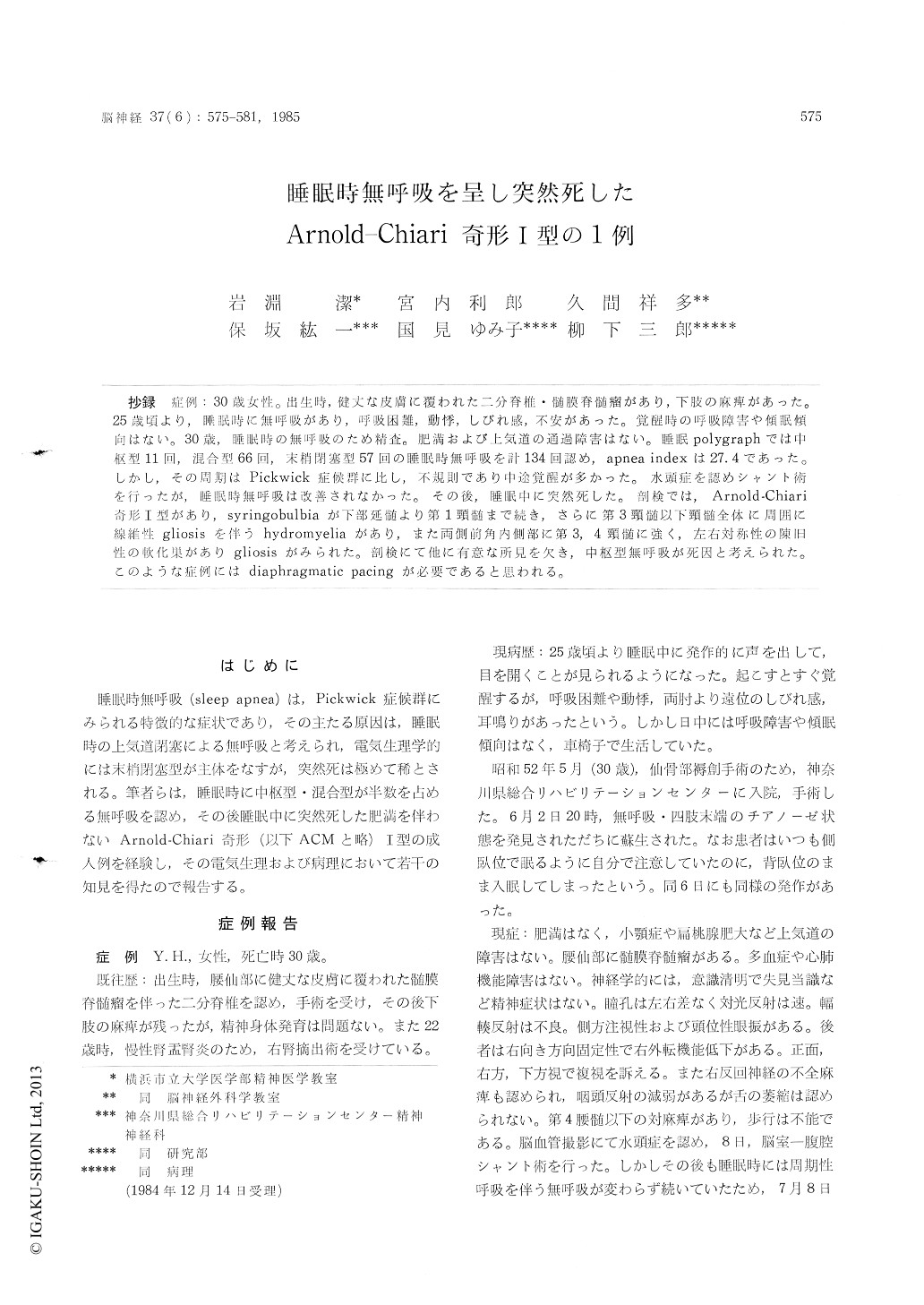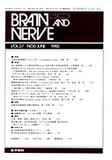Japanese
English
- 有料閲覧
- Abstract 文献概要
- 1ページ目 Look Inside
抄録 症例:30歳女性。出生時,健丈な皮膚に覆われた二分脊椎・髄膜脊髄瘤があり,下肢の麻痺があった。25歳頃より,睡眠時に無呼吸があり,呼吸困難,動悸,しびれ感,不安があった。覚醒時の呼吸障害や傾眠傾向はない。30歳,睡眠時の無呼吸のため精査。肥満および上気道の通過障害はない。睡眠polygraphでは中枢型11回,混合型66回,末梢閉塞型57回の睡眠時無呼吸を計134回認め,apnea indexは27.4であった。しかし,その周期はPickwick症候群に比し,不規則であり中途覚醒が多かった。水頭症を認めシャント術を行ったが,睡眠時無呼吸は改善されなかった。その後,睡眠中に突然死した。剖検では,Arnold-Chiari奇形1型があり,syringobulbiaが下部延髄より第1頸髄まで続き,さらに第3頸髄以下頸髄全体に周囲に線維性gliosisを伴うhydromyeliaがあり,また両側前角内側部に第3,4頸髄に強く,左右対称性の陳旧性の軟化巣がありgliosisがみられた。剖検にて他に有意な所見を欠き,中枢型無呼吸が死因と考えられた。このような症例にはdiaphragmatic pacingが必要であると思われる。
We presented a sudden-death case of Arnold-Chiari malformation (type 1) accompanied with spina bifida and closed meningomyelocele. Poly-somnography revealed the increase of both central and mixed type apneas to compare with the find-ings of typical Pickwikian syndrome.
The case: 30-year-old female without obese or obstruction of upper air way. Spina bifida and closed meningomyelocele at sacral portion were found at her birth. She had no treatment and had not been able to walk because of paralysis at low extremities. Since she was 25-year-old, she had had inosomia which accompanied by choked feelings, palpitations, clumsiness of hands and anxiety. Snoring was light, and she had neither respiratory disturbances nor hypersomnia during awake. She was admitted to our hospital for treatment of decubitus.
2nd June, 1977, she was found acrocyanosis during sleep and immediatly she was resurrected. Physical examinations revealed there was no accounting for sudden respiratory arrest: the cardio-pulmonary system was normal during awake and laboratory findings also failed to diclose the episode. But she had slight dysfunctions of lower cranial nerves : fine nystagmus acording to the head-position, decreased gag reflex, and paresis in the reccurence nerve of N.XII and etc. Angiography showed communicating hydrocephalus. Though ventriculo-peritoneal shunt operation was performed at 8th June, sleep apnea could not be improved. Therfore we examined in order to claryfy her sleep apnea. She was not obese, we could not find any obstruc-tions at upper air way. Nocturnal polygraphy was performed at 8 th July. The results were sum-marized as follows: (1) Total sleep ti me was 293 minutes and numbers of sleep apnea were 134 times. Apnea index was 27.4. (2) Sleep apneas were divided into three types ; central type (11 times), mixed type (57 times), and peripheral type (66 times). (3) The interval between each sleep apnea was not so periodic compaired with that of typical Pickwickian syndrome. (4) Another finding was that her sleep was sometimes inter-rupted by awake. Nine days later, at 17th June, she was found died during her sleep without any physical trouble.
The general autopsy did not reveal any mor-phological lesions causing sudden death : espe-cially normal at the lung including air pathway and the heart. In the brain, there existed Arnold-Chiari malformation (type 1) with downward deviation of cerebellar vermis at first cervical vertebra and narrowing and elongation of medulla oblongata. At medulla oblongata, hydrobulbia ac-companied with syringobulbia which was found at tegmentum and severe fibrous gliosis existed around it. Though the second cervical cord was normal, hydrornyelia was found from the third to the eighth cervical cord. Moreover, we found the old softening foci with fibrous gliosis at ante-rolateral portion bilaterally.
The causes of sudden death during sleep were thought the dysfunction of the central nervous system, mainly that of brainstem because there were no lesions that induced acute cardiopulmo-nary arrest like sudden death of Pickwickiansyndrome and the occurrence of central and mixed type apnea was increased in number to compare with that of typical Pickwickian syndrome on the polysomnography.

Copyright © 1985, Igaku-Shoin Ltd. All rights reserved.


